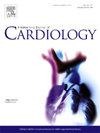急性或复发性心包炎心包组织的定量分析。
IF 3.2
2区 医学
Q2 CARDIAC & CARDIOVASCULAR SYSTEMS
引用次数: 0
摘要
背景:心脏磁共振(CMR)对心包炎的预后分层越来越重要,但目前使用CMR定量评估心包炎症的数据有限。本研究的目的是评估心包组织特征在急性或复发性心包炎预后预测中的定量方法的效用。材料和方法:纳入连续接受CMR治疗急性或复发性心包炎的患者, > 6 个月临床随访(FU)。采用不同技术定量评价心包水肿和晚期钆增强(LGE)量以及心包炎症成像T1/T2最大值。连续变量表示为平均值 ± SD或中位数(IQR)。采用单因素/多因素Cox回归分析不同CMR定量参数与临床结局之间的关系。结果:61例患者(平均年龄:48 ± 18 岁;男性41例( %),其中46例(75 %)患有急性心包炎。FWHM、5、6 SD测量心包LGE中位值分别为31.2(9;54.5)、42.7(17.2;72.5)、38.8(15.2;69)cm3。心包T1和T2中位值分别为1356(1305;1523)ms和77(73;81)ms。在12 个月FU时,20例(32 %)患者达到包括复发、收缩演变和右心衰的复合结局。在全球队列中,定量LGE与心包炎复发和综合预后相关,而在急性心包炎队列中,与心包炎复发相关,但T1、T2定位值和T2w图像均与此无关。结论:不同技术的LGE定量评估,而非参数制图,显示与急性和复发性心包炎的临床预后预测相关,证实LGE目前是最准确的影像学标志物,具有预后价值。本文章由计算机程序翻译,如有差异,请以英文原文为准。
Pericardial tissue characterization with quantitative methods in cardiac magnetic resonance in acute or recurrent pericarditis
Background
Cardiac Magnetic Resonance(CMR) is gaining importance for prognosis stratification of pericarditis,but data on quantitative evaluation of pericardial inflammation with CMR are currently limited. Aim of the study is to assess the utility of tissue characterization of pericardium with quantitative methods in outcome prediction of acute or recurrent pericarditis.
Materials and methods
Consecutive patients who performed CMR for acute or recurrent pericarditis and > 6 months clinical follow up (FU) were enrolled. Quantitative evaluation of oedema and late gadolinium enhancement (LGE) amount on pericardium with different techniques and T1/T2 maximum values on inflamed pericardium with mapping were performed. The continuous variables are presented as mean ± SD or median (IQR) as appropriate. Univariate/multivariate Cox regressions were used to investigate the association between the different CMR quantitative parameters and clinical outcome.
Results
Sixty-one patients(mean age:48 ± 18 years; male:41 %) were enrolled, whose 46 (75 %) with acute pericarditis. Pericardial LGE median amount was 31.2(9;54.5), 42.7(17.2;72.5) and 38.8(15.2;69)cm3 when measured with FWHM, 5 and 6 SD, respectively. Median pericardial T1 and T2 values were 1356(1305;1523)ms and 77(73;81)ms, respectively. At 12 months FU, 20(32 %) patients reached the composite outcome including recurrence, constrictive evolution and right heart failure. Quantitative LGE, but neither T1 nor T2 mapping values nor T2w image, was associated to pericarditis recurrence and composite outcome in global cohort and to pericarditis recurrence in acute pericarditis cohort.
Conclusion
Quantitative LGE evaluation with different techniques, but not parametric mapping, showed an association with clinical outcome prediction in acute and recurrent pericarditis, confirming LGE currently represents the most accurate imaging marker with prognostic value in this setting.
求助全文
通过发布文献求助,成功后即可免费获取论文全文。
去求助
来源期刊

International journal of cardiology
医学-心血管系统
CiteScore
6.80
自引率
5.70%
发文量
758
审稿时长
44 days
期刊介绍:
The International Journal of Cardiology is devoted to cardiology in the broadest sense. Both basic research and clinical papers can be submitted. The journal serves the interest of both practicing clinicians and researchers.
In addition to original papers, we are launching a range of new manuscript types, including Consensus and Position Papers, Systematic Reviews, Meta-analyses, and Short communications. Case reports are no longer acceptable. Controversial techniques, issues on health policy and social medicine are discussed and serve as useful tools for encouraging debate.
 求助内容:
求助内容: 应助结果提醒方式:
应助结果提醒方式:


